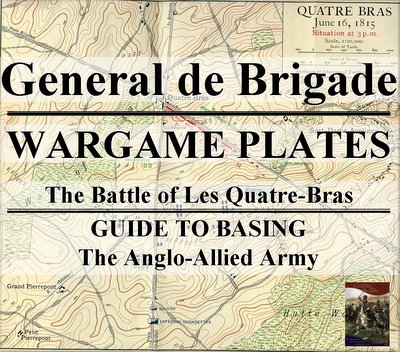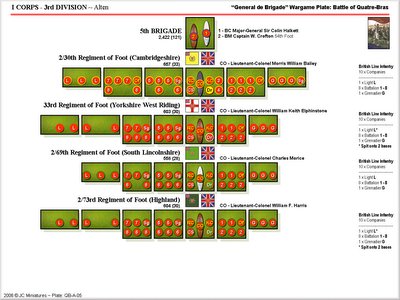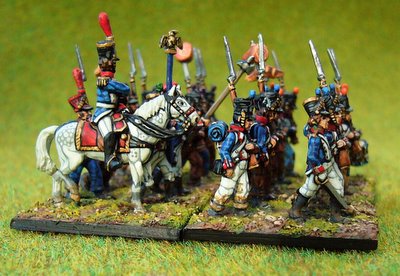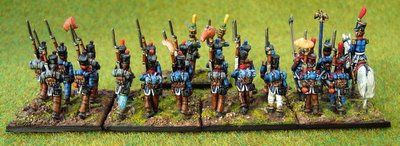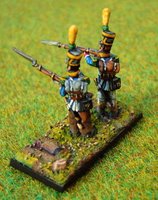
The Brunswickers were follow shortly then the French. Please post any comments on my YAHOO QUATRE-BRAS FORUM. To view photos of miniatures, go to my gallery. Thanks.
UPDATE: I will be updating all the plates by adding the recommended formation for each unit thus helping you select the correct poses for the miniatures you buy, i.e. certain regiments were in square formation others in skirmish order.
27 February 2006
BRUNSWICKERS TO FOLLOW SHORTLY
Posted by
JC - Painter of Miniatures
1 comments
![]()
5th DIVISION - 9th British Infantry Brigade

~ General de Brigade Wargame Plate: Battle of Quatre-Bras ~
ANGLO-ALLIED ARMY
Plate: QB-A-13 - RESERVE CORPS - 5th DIVISION
~ 9th BRITISH INFANTRY BRIGADE ~
IMPORTANT: Please refer to the “Symbols & Abbreviations” plate for nomenclature & icons used on each wargame plate. If anyone does spot a glaring error, please email me direct at j.cutting1@btinternet.com and I will re-edit the plate, if required.
Posted by
JC - Painter of Miniatures
0
comments
![]()
5th DIVISION - 8th British Infantry Brigade
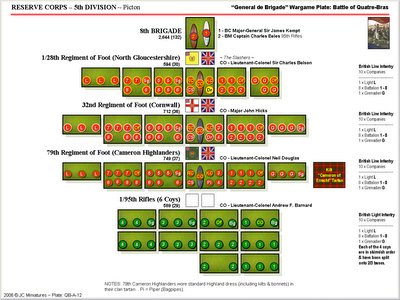
~ General de Brigade Wargame Plate: Battle of Quatre-Bras ~
ANGLO-ALLIED ARMY
Plate: QB-A-12 - RESERVE CORPS - 5th DIVISION
~ 5th BRITISH INFANTRY BRIGADE ~
IMPORTANT: Please refer to the “Symbols & Abbreviations” plate for nomenclature & icons used on each wargame plate. If anyone does spot a glaring error, please email me direct at j.cutting1@btinternet.com and I will re-edit the plate, if required.
Posted by
JC - Painter of Miniatures
0
comments
![]()
26 February 2006
5th DIVISION - Command & Artillery

~ General de Brigade Wargame Plate: Battle of Quatre-Bras ~
ANGLO-ALLIED ARMY
Plate: QB-A-11 - RESERVE CORPS - 5th DIVISION
~ COMMAND & DIVISIONAL ARTILLERY~
IMPORTANT: Please refer to the “Symbols & Abbreviations” plate for nomenclature & icons used on each wargame plate. If anyone does spot a glaring error, please email me direct at j.cutting1@btinternet.com and I will re-edit the plate, if required.
Posted by
JC - Painter of Miniatures
0
comments
![]()
6th DIVISION - 4th Hanoverian Infantry Brigade
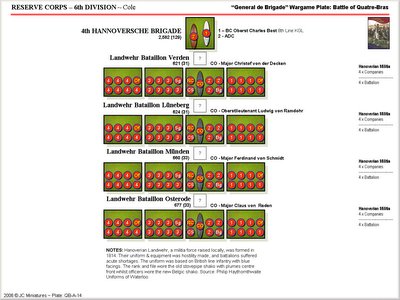
~ General de Brigade Wargame Plate: Battle of Quatre-Bras ~
ANGLO-ALLIED ARMY
Plate: QB-A-14 - RESERVE CORPS - 6th DIVISION
~ 4th HANOVERIAN INFANTRY BRIGADE ~
IMPORTANT: Please refer to the “Symbols & Abbreviations” plate for nomenclature & icons used on each wargame plate. If anyone does spot a glaring error, please email me direct at j.cutting1@btinternet.com and I will re-edit the plate, if required.
Posted by
JC - Painter of Miniatures
0
comments
![]()
25 February 2006
WARGAME PLATES - BASING MINIATURES
The following wargame plates that I specially compiled have been designed for all Napoleonic wargamers but especially for those of you using Dabid brown's General de Brigade rules set.
Each plate enables the wargamer to base precisely any of the units present at the Battle of Les Quatre-Bras during the Waterloo Campaign detailing basing guidelines according to the unit’s military structure specific to Belgian, British, Brunswick, Dutch, French, Hanoverian, King’s German Legion (KGL) & Prussian infantry, artillery and cavalry.
Base sizes stated on the “Symbols & Abbreviations” plate are for 25mm - 28mm gaming and are only suggestions. Base sizes are not vital to the game as long as wargamers use the same basing for all units.
Unlike the rules set, where David Brown recommends keeping unit depths to a minimum, I personally recommend leaving 10mm of space at the front of each infantry and cavalry unit to accommodate figures charging, advancing or firing. This allows the gamer to place company bases flush against each other when moving an entire unit(s) in column of companies or squadrons, column of divisions or massed infantry columns.
Compiling the unit strengths has been quite difficult especially as most recent Waterloo Orbats are for the Battle of Waterloo on 18 June sic taking into account losses sustained at the Battles of Gilly, Les Quatre-Bras and Ligny. The unit strengths on each plate have been taken from a number of sources including Siborne’s History of the Waterloo Campaign, Scott Bowden’s Armies at Waterloo and De Bas & Wommersen’s La Campagne de 1815 aux Pays-Bas d'apres les Rapports Officiels Neerlandais and, like any OOB, are subject to debate. I am certain is that the unit strengths are pretty close to the actual number of soldiers present on the day give or take 20 men and hopefully provide a basis for building a regiment, battalion or artillery battery more accurately.
IMPORTANT:
I advise all readers to take note of my “Symbols & Abbreviations” plate in order to fully understand the nomenclature & icons used on each wargame plate. If anyone does spot a glaring error, please email me direct at j.cutting1@btinternet.com and I will re-edit the plate, if required.
WARGAMING PLATES UPDATE:
I will post the remainder of the Anglo-Allied wargame plates over the weekend and the French Orbat will swiftly follow. I will then update existing UNIFORM PLATES and continue to compile new plates for each unit present at the battle.
HARDCOPY PRINTED VERSION:
Finally, for those who have already asked and for those interested, I plan to make available high quality printed versions of each wargame plate featured on my blog for both the Anglo-Allied & French army in the very near future. If you are interested, then can I recommend you subscribe to my Yahoo Forum - “The Battle of Quatre-Bras” (button on my menu bar) and I will keep you posted as to the date when they will become available.
Many thanks and all feedback is extremely appreciated.
JC
Posted by
JC - Painter of Miniatures
0
comments
![]()
3rd DIVISION - 1st Hanoverian Infantry Brigade

~ General de Brigade Wargame Plate: Battle of Quatre-Bras ~
ANGLO-ALLIED ARMY
Plate: QB-A-06 - I CORPS - 3rd DIVISION
~ 1st HANOVERIAN INFANTRY BRIGADE ~
IMPORTANT: Please refer to the “Symbols & Abbreviations” plate for nomenclature & icons used on each wargame plate. If anyone does spot a glaring error, please email me direct at j.cutting1@btinternet.com and I will re-edit the plate, if required.
Posted by
JC - Painter of Miniatures
0
comments
![]()
3rd DIVISION - 5th British Infantry Brigade
IMPORTANT: Please refer to the “Symbols & Abbreviations” plate for nomenclature & icons used on each wargame plate. If anyone does spot a glaring error, please email me direct at j.cutting1@btinternet.com and I will re-edit the plate, if required.
Posted by
JC - Painter of Miniatures
0
comments
![]()
1st DIVISION - 1st & 2nd British Infantry Brigades

~ General de Brigade Wargame Plate: Battle of Quatre-Bras ~
ANGLO-ALLIED ARMY
Plate: QB-A-03 - I CORPS - 1st DIVISION
Posted by
JC - Painter of Miniatures
0
comments
![]()
20 February 2006
NEW PLATES COMING SOON!
Apologies for my online inactivity. I can reassure you that offline, I’ve been hard at work and will be posting several more Anglo-Allied contingent plates this week – so watch this space.
It would appear the site has attracted a healthy following including both the Napoleonic purist and the gamer and so I’ve spent the last week wrestling with the dilemma of endeavouring to satisfy both. Thanks for all the comments to date either direct to my email or on the Quatre-Bras forum. Do keep them coming. A special mention must go to the “Napoleonic Series Discussion Forum” and its’ astute & wise membership – whilst inspirational in its comments, I now find myself more deeply immersed in a subject that I thought could be dealt with far more simply.
The key element behind realising this project has to be the “Order of Battle” for Quatre-Bras, in effect the troop strengths for units before hostilities began – something that I imagined would be simple to ascertain yet I couldn’t more wrong. To my amazement most Waterloo Campaign OOBs deviate from one historian to the next. On reflection, the QB OOB seems to have undergone an historical version of Chinese whispers resulting in highly contradictory figures whatever their source material. Despite my own rather predictable sources – Haythorntwaite, Hofschroer, Fortescue, Chartrand and the recent work by Adkin, all they seem to have done is confuse the issue further. So I have been advised to read Bas and Wommersom’s volume I on Quatre-Bras – supposedly a definitive source as well as Alain Arcq "Les Quatre-Bras 16 Juin 1815" – sadly both are rather hard to get hold of. Back to the point of a core source for troop strengths at the onset of the campaign, I’m amazed there is no one definitive source that everyone else quotes. OK, troops get sick, desert, miss boats, get lost etc. but that still doesn’t explain why no two OOBs are the same and that doesn’t even take into account the different names used for the units present, i.e. 27th Jägers, Bataljon Jagers No.27, 27th Dutch Jaeger, 27th Jager, 27th (Dutch) Chasseurs – need I continue! The deeper I dig, the more complex it becomes and the more frustrated I become with the damn academics behind them! Sure, that’s the beauty of history, I hear you say but I disagree. It would appear that the French and British 19th century historians have a lot to answer for, who, like Wellington continued to bend the truth or worse still, simply lie! What we are left with is a welter of conflicting stories, views and opinions that, rather than shedding new light, simply cast us deeper into the shadows – “Quelle Affaire!”
So I will ask you directly, “Is there a near definitive source for Anglo-Allied unit strengths at the onset of the Waterloo Campaign?” And if so, do enlighten me because without this I cannot begin!
JC
PS. Here's my Anglo-Allied OOB (June 15) - a working draft and a bit of a mess but interesting reading nonetheless.
ANGLO-ALLIED FORCES PRESENT AT THE BATTLE OF QUATRE BRAS 34,219
C-in-C: Field Marshal Sir Arthur Wellesley, Duke of Wellington
STAFF:
COS: Colonel Sir William de Lancey (QMG, acting COS)
Quartermaster-General: Sir George MurrayDeputy Quartermaster-General: Sir Alexander Dickson, RHAAssistant Quartermaster-Genera: Lieutenant-Colonel Sir Charles Broke
Adjutant-General: Major-General Sir Edward Barnes
Foot Artillery Command: Colonel Sir George Adam Wood RA
STAFF: 2 field officers, 1 surgeon, 1 sergeant, 1 veterinary surgeonHorse Artillery Command: Colonel Sir Augustus Frazer RHA
King's German Artillery: Lieutenant-Colonel Sir Julius Hartmann
ADCs:Colonel Charles Fox Canning [Regt?]
Colonel James Stanhope [Regt?]Lieutenant-Colonel Sir Alexander Gordon (92nd Highlanders]
Major Henry Percy [Regt?]Captain Lord Arthur Hill [Regt?]
Sir James Shaw Kennedy
Colin Campbell
------------------------
I Corps: GOC H.R.H Majoor-General Prince William of Orange
STAFF:
cos: Generaal-Majoor Baron J.V. Constant-Rebecque
ADCs: Lieutenant-Colonel Baron Tripp [60th Foot]Captain Lord John Somerset Captain The Honourable Francis Russell
Extra ADCs: Captain The Earl of March [52nd Foot]Captain Viscount Bury [1st Foot Guards]Lieutenant Sir Harry Webster [9th Light Dragoons]
Lord March (Duke of Richmond's son) [Regt?]
----------------------------------------------------------
1st Division GOC Major-General Sir George Cooke 4,675 ~ Gentlemen Sons
STAFF:
ADCs: Captain G. Disbrowe [1st Guards]
Ensign Augustus Cuyler [2nd Guards (Coldstream)]
--------------------------
1st Brigade GOC Major-General Sir Peregrine Maitland 2,087
Brigade Major: Captain J. Gunthorpe [1st Guards]
ADCs: Ensign James, Lord Hay [1st Guards]
2/1st Foot Guards - Major Henry Askew 1,021 The Tow-Rows
3/1st Foot Guards - Major Hon. William Stewart/ Captain F. Powell 1,066 The Tow-Rows
2nd Brigade GOC Major-General Sir John Byng 2,148
2/2nd (Coldstream) Guards - Major A. G. Woodford 1,044 The Coldstreamers
2/3rd (Scots) Guards - Major Francis Hepburn 1,104
Division Artillery GOC Lieutenant-Colonel S. G. Adye 440
Sandham’s Battery, RFA 5 x 9-pdrs / 1 x 5.5-in. howitzer Captain Charles F. Sandham (215)
2nd Horse Battery KGL x 9-pdrs / 1 x 5.5-in. howitzer (225) Brevet Major (Captain) Heinrich Jakob Kuhlmann Kühlmann
1 captain, 3 subalterns, 1 surgeon, 4 sergeants, 3 corporals, 6 bombardiers, 72 gunners, 58 drivers, 6 craftsmen, 164 horses 5 six-pounder cannon, one 5.5-inch howitzer.
----------------------------------------------------------
3rd Division GOC Major-General Count Sir Karl von Alten 6,251 ~ Fighting Division
STAFF:
COS: Colonel August von Berger
ADCs: Major A. Heise [2nd Light Battalion KGL]
Lieutenant W. Havelock [43rd Regiment of Foot]
--------------------------
5th Brigade GOC Maj-Gen. Sir Colin Halkett 2,422
2/30th Regiment of Foot (Cambridgeshire) - Lieutenant-Colonel Morris William Bailey 657 The Three Tens 615 635 635
33rd Regiment of Foot (Yorkshire West Riding) - Lieutenant-Colonel William Keith Elphinstone 603 - Wellington’s old regiment The Havercake Lads 561 561 576
2/69th Regiment of Foot (South Lincolnshire) - Lieutenant-Colonel Charles Morice / Major G. Muttlebury 558 The Up & Downs ~ The Old Agamemnons 516 - 565
2/73rd Regiment of Foot (Highland) - Lieutenant-Colonel William George Harris 604 – 562 562 498657
1st Hanoverian Brigade GOC Major-General Graf von Kielmansegge 3,414
Field Battalion of the Grubenhagen Regiment (Leichte) - Lt-Col. Wurmb 661
Field Battalion of the Bremen Regiment (Leichte) - Lt-Col. Langrehr 552
Field Battalion of the Lüneburg Regiment (Leichte) - Lt-Col. von Klencke 635
Field Battalion of the Osnabruck Regiment (Herzog von York) (Leichte) - Maj. Baron Bulow 647
*Verden Field Battalion - Maj. de Schkopp 573
*Field Battalion of the Calenberg Regiment - Maj. de Schkopp 573
Kielmansegge Feldjäger-Korps (? Companies)– Capt. von Reden 340
Division Artillery GOC Lieutenant-Colonel J. S. Williamson
Lloyd’s Battery, RFA 5 x 9-pdrs / 1 x 5.5-in. howitzer Major W. Lloyd (200)
Cleeve’s Battery, 1st/4th? Foot Battery, KGL 5 x 9-pdrs / 1 x 5.5-in. howitzer Captain Andreas Cleeves (215)
Captain, 4 subalterns, 1 surgeon, 4 sergeants, 3 corporals, 5 bombardiers, 65 gunners, 2 buglers - train: 3 sergeants, 5 corporals, 98 drivers, 15 craftsmen, 124 horses with 5 six-pounder cannon, one 5 .5-inch howitzer
----------------------------------------------------------
2nd NETHERLANDS DIVISION
GOC Lt-Gen. Baron Henri-Georges de Perponcher-Sedlnitzky 7,936?
STAFF
Chief of Staff: Colonel Baron P.H. van Zuylen van Nyevelt
Adjutants: Majoor J. van de Poll
Kapitein F.P. de Smeth van Deurne [Regt?]
ADCs: Majoor G.G. Taets van Amerongen [Regt?]
Kapitein F.B. von Gagern [Regt?]
Luitenant Chalmers [Regt?]
1e Luitenant-ter-zee C. Hoynck van Papendrecht [Regt?]
Commandant of Artillery: Majoor C. van Opstall
Commandant of Police: Kapitein A. J. Gobelet
--------------------------
1st Brigade GOC Generaal-Majoor W.F. Graf van Bijlandt 3,233
Brigade-Majoor: Kapitein Ph. J. van Zuylen van Nyevelt
Adjutant: Kapitein P. Rendorp
ADCs: Kapitein G.J. van Hogendorp, 1e Luitenant C.F. van Haren
--------------------------
Bataljon van Linie No.7 (Dutch/Belgian?) Luitenant-Colonel F. C. Vandensande 701
Bataljon Jagers No.27 (Dutch) Luitenant-Colonel W. J. Grunebosch 809
Bataljon Nationale Militie No.5 (Dutch) Luitenant-Colonel J. J. Westenberg 482
Bataljon Nationale Militie No.7 (Dutch) Luitenant-Colonel H. Singendonck 675
Bataljon Nationale Militie No.8 (Dutch) Luitenant-Colonel W. A. de Jongh 566
2nd Brigade GOC Colonel H.S.H Prinz Bernard von Sachsen-Weimar [1] 4,477
Brigade-Majoor: Hauptmann A. Coustol / Majoor F. Sattler
Adjutant: Hauptmann Baron von Gagern
ADC: Major L. Vigelius
--------------------------
CO Majoor F. Sattler? / Colonel F W van Goedececke 2,738?
1/2nd Nassau-Usingen Majoor J. F. Sattler /Kapitein Busgen 903
2/2nd Nassau-Usingen Majoor Ph. von Normann 903
3/2nd Nassau-Usingen Majoor G. Hegmann 903
CO Colonel H.S.H Prinz Bernard von Sachsen-Weimar 1,593?
1/Regiment Oranje-Nassau No.28 Luitenant-Colonel W.F. von Dressel 795
2/Regiment Oranje-Nassau No.28 Major P. Schleyer 796
Freywillige Oranische Jager-Kompanie (Volunteers Jaegers – Nassau) Captain E. Bergmann 177
Division Artillery GOC Major van Opstal
Bijleveld’s Battery, HA (Dutch) Kapitein A. Bijleveld 6 x 6-pdrs / 2 x 5.5-in. howitzer (107)
***Some sources state Bijleveld had 2 x French 24-pounders***
Bijleveld’s Artillery Train - 1e Luitenant van der Hoeven (111** / 112***)
13 x artillery ammunition caissons
6 x wagons
Stievenert’s Battery, FA (Belgian) Kapitein E. J. Stevenart 6 x 6-pdrs / 2 x 5.5-in. howitzer (119)Stievenert’s Artillery Train - 1e Luitenant van Gahlen (128 / 139***)13 x artillery ammunition caissons 16 x infantry ammunition caissons 7 x wagons
----------------------------------------------------------
NETHERLANDS CAVALRY DIVISION
3pm 2ND Light Brigade - van Merlen 1,082
--------------------------
2nd (Dutch-Belgian) Light Cavalry Brigade - Generaal-Majoor J.B. van Merlen
Regiment Lichte Dragonders No.5 Luitenant-Colonel E.A.J.G. de Merex (647 in 4 sqn.)
Regiment Huzaren No.6 (Dutch) - Luitenant-Colonel W. F. Bereel (439 in 3 sqn.)
Petter’s 1/2 HA (Dutch) 3 x 6-pdrs / 1 x 5.5-in. howitzer
----------------------------------------------------------
RESERVE CORPS – Duke of Wellington
----------------------------------------------------------
5th division – Picton 5,467 ~ Pioneers
--------------------------
8th Brigade – Kempt 2,644
1/28th Foot (North Gloucestershire) 594 The Slashers
1/32nd Foot (Cornwall) 712
1/79th Foot (Cameron Highlanders) 749
1/95th Rifles - 6 Coys 589 The Rifles ~ Manningham’s Sharpshooters ~ The Sweeps ~ The Grasshoppers ~
9th Brigade – Pack 2,323
3/1st Foot (Royal Scots) 648 ~ Pontius Pilate’s Bodyguard
1/42nd Foot (Royal Highland) 561 ~ The Forty-Twa
2/44th Foot (East Sussex) 485 ~ Little Fighting Fours
1/92nd Gordon Highlanders 629 ~ Gay Gordon’s
Division Artillery
Roger’s Battery, RFA 5 x 9-pdrs / 1 x 5.5-in. howitzer (263)
Braun’s Battery, Hanoverian FA 5 x 6-pdrs / 1 x 5.5-in. howitzer Captain Wilhelm Braun (237)
----------------------------------------------------------
6th division – Cole ~ The Marching Division
--------------------------
4th Hanoverian Brigade – Best 2,742
Verden Landwehr Battalion 661
Lüneburg Landwehr Battalion 664
Osterode Landwehr Battalion 717
Münden Landwehr Battalion 700
----------------------------------------------------------
Brunswick CONTINGENT: Duke of Brunswick 6,066?
--------------------------
Advanced Guard - von Rauschenplatt 675
Jäger Battalion 675
Light Brigade - von Buttlar 2,688
Light Btn. "Leib" (Garde) 672
1st Light Battalion "Leib" 672
2nd Light Battalion "Leib" 672 / 688
3rd Light Battalion "Leib” 672 / 691
Line Brigade - von Specht 2,016
1st Line Battalion 672
2nd Line Battalion 672
3rd Line Battalion 672
Divisional Artillery
von Moll’s Brunswick FA 8 x 6-pdr (205)
von Heinemann Brunswick HA 8 x 6pdr (167)
Cavalry Brigade 990
2nd Hussar (Brunswick) 690 / 727
Uhlans (Brunswick) 232 / 246
Field Gendarmes or Polizei Huzaren (Brunswick) 17
----------------------------------------------------------
Posted by
JC - Painter of Miniatures
1 comments
![]()
15 February 2006
NEW DESIGN - GIVE ME YOUR FEEDBACK
NEW TEMPLATE DESIGNS FOR QUATRE-BRAS
Before immersing myself too deeply in this somewhat daunting project, I have decided to hone the design templates for each FACT SHEET depicting infantry, cavalry & artillery units present at the "Battle of Quatre-Bras" - practice makes perfect!
In essence, these fact sheets are designed as a "useful aid" for any Napoleonic enthusiast wishing to build a specific unit (company, batallion, regiment or battery) for display or wargaming according to my rules set of choice - David Brown's excellent , General de Brigade where 1 figure = 20 men.
All future fact sheets will be designed to provide detailed basing instructions according to the relevant unit's troop strength at the battle and feature a painting guide using the exquisite uniform designs of Alexis Cabaret. My wish is that they become a useful resource to Napoleonic painters & wargamers alike and helpful tool when purchasing miniatures; basing them more accurately and ultimately painting them.
Ahead of me, lies a momentous task and will gladly put all my effort into. I have 60 Anglo-Allied and 30 French Fact Sheets to build - and hope to produce them comparatively quickly once I'm happy with the layout and design for each infantry, cavalry, artillery & command (Division & Brigade) template.
I have posted my new template for an Infantry Regiment below, and you’ll immediately notice that I have removed it’s "Action Summary" on the battlefield. Firstly, because I want more space to show the formations of the unit and their uniforms and secondly, there are enough books out their about the battle as well as the rules set. I will continue to give an overview of the unit’s involvement at Quatre-Bras but will place it directly below each fact sheet & on my blog instead.
YOUR FEEDBACK
What I would appreciate is any constructive criticism about this draft below and what one would like to see? So before I begin in earnest on other infantry regiments at the battle, I’d like to hear your comments.
Look forward to hearing from you,
JC
INFANTRY TEMPLATE
Generale de Brigade Unit Fact Sheet "Design Template"
Posted by
JC - Painter of Miniatures
2
comments
![]()
14 February 2006
UPDATE: Moll's Battery, Brunswick FA
-----------------------------------------------------------------------------
General de Brigade Fact Sheet: Battle of Quatre-Bras
The Brunswick artillery up to 1809 was supplied by the Austrians but left behind when they were evacuated to England. During their time in British service they had no artillery until 1814 when the Brunswick artillery was reformed using French equipment bought from captured ordnance after the Battle of Leipzig (16 October 1813) – incidentally the largest conflict in the Napoleonic Wars and the most decisive defeat suffered by Napoleon Bonaparte before the Battle of Waterloo.
Many historians state they were equipped with French / Westphalian ordnance during the Waterloo campaign, especially as Brunswick was a French satellite until Napoleon’s abdication on 6 April 1814. Yet some Waterloo commentators believe, that similar to the French army of 1944 where most equipment was supplied by the Americans, the Brunswickers were similarly supplied with British ordnance. The best answer to the wargamer is possibly a mix of both French 6-pounders and British 6-pounders (see updated "Fact Sheet") assuming that some of the Brunswicker's French ordnance has been replaced through damage, i.e. an axle breaking etc.
[Author's note: Make I thank Cliff for pointing this out to me on my Yahoo Forum and thanks go to comments posted on The Miniature World of Joe Videki.]
Links:
Uniform: Brunswick Foot Artillery [Click on Unites & Uniformes]
Braunschweiger Feldkorps (German only)
General de Brigade Rules
----------------------------------------------------------------------------
Posted by
JC - Painter of Miniatures
0
comments
![]()
My "Napoleonic Web Site of the Week"
----------------------------------------------------------------------------------------------
c.1817 Napoleon 1st at St. Helena
Source:
Brown University Library
...Click on drop down menu to view their brilliant collection of Napoleonic cartoons titled, Napoleonic Satires. Then click "Browse". This will take you to a page to view 423 cartoons from the period. Click on an image and the cartoon literally comes to life! Voila!
As a former cartoonist for a UK national magazine, they are not only superbly drawn but extremely evocative of the time...to quote from the site, "Considered with other forms of military memorabilia, satiric prints serve as a reminder that printed images were effectively used as a weapon of sorts. As such, satires made in Britain and continental Europe that depict Napoleon as a diminutive brat combat Napoleon's self-constructed imperial image as a powerful god-like ruler. Satires such as these participate in a broad conversation that spans genres to suggest that the official French images of Napoleon are no more authentic or permanent than the satiric image. To this day Napoleon's imperial image is popularly conflated with his satirical representation - namely his short stature, which is largely a satiric invention."
I envisage some of these images augmenting many a Napoleonic web site in the foreseeable future!
----------------------------------------------------------------------------------------------
Posted by
JC - Painter of Miniatures
1 comments
![]()
13 February 2006
Regiment Lichte Dragonders No.5 (Belgian)
------------------------------------------------------------------------------------------
General de Brigade Fact Sheet: Battle of Quatre-Bras
Links:
Uniform: Regiment Lichte Dragonders No.5 (Belgian)
General de Brigade Rules
-----------------------------------------------------------------------------------------
Posted by
JC - Painter of Miniatures
0
comments
![]()
Bataljon Jägers No.27 (Dutch)
------------------------------------------------------------------------------------------
General de Brigade Fact Sheet: Battle of Quatre-Bras
[Version 1 - Based in Close Order]
[Version 2 - Based for Skirmishing]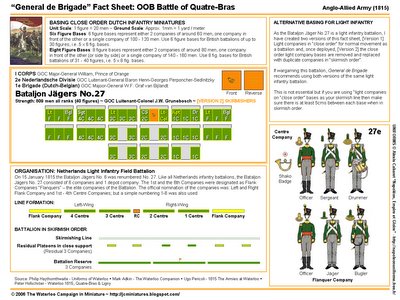
Links:
Uniform: Bataljon Jägers Centre Company
Uniform: Bataljon Jägers Flank Company
About the Bataljon Jägers No.27 (Dutch)
Organisation of the Army of the Netherlands in 1815
Netherlands OOB - 2e Nederlandische Divisie
General de Brigade Rules
----------------------------------------------------------------------------------------
Posted by
JC - Painter of Miniatures
1 comments
![]()
Braun's Battery, Hanoverian FA
------------------------------------------------------------------------------------
General de Brigade Fact Sheet: Battle of Quatre-Bras
Links:
Unifrom: Hanoverian Foot Artillery [Same as RFA]
General de Brigade Rules
-----------------------------------------------------------------------------------
Posted by
JC - Painter of Miniatures
0
comments
![]()
6th Regiment Huzaren (Dutch)
-------------------------------------------------------------------------------
General de Brigade Fact Sheet: Battle of Quatre-Bras
Links:
Uniform: 6th Regiment Huzaren (Dutch)
General de Brigade Rules
------------------------------------------------------------------------------
Posted by
JC - Painter of Miniatures
0
comments
![]()
Rogers' Brigade, RFA
-----------------------------------------------------------------------------
General de Brigade Fact Sheet: Battle of Quatre-Bras
Links:
Uniform: Royal Foot Artillery
British Artillery during the Napoleonic Wars
General de Brigade
----------------------------------------------------------------------------
Posted by
JC - Painter of Miniatures
0
comments
![]()
28th Regiment of Foot
-------------------------------------------------------------------------------
General de Brigade Fact Sheet: Battle of Quatre-Bras
Links:
Uniform: 28th Foot Light Company
Uniform: 28th Foot Centre Company
Uniform: 28th Foot Grenadier Company
Colours: Flags of the Napoleonic Wars
General de Brigade Rules
-------------------------------------------------------------------------------
Posted by
JC - Painter of Miniatures
1 comments
![]()
11 February 2006
THE BIG 4
Just in case those of you think this is a site simply dedicated to OOBs...let me give a quick mention to my favourite 28mm Napoleonic miniature manufacturers. See my Links to view the excellent painting of Martin Kelly, Spencer Keen & Steve Dean to name but three!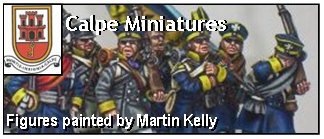
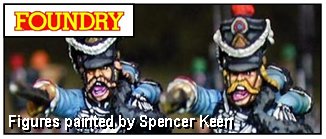


Posted by
JC - Painter of Miniatures
1 comments
![]()
Anglo-Allied OOB posted
Battle of Quatre-Bras
I have finally put together pretty much a definitive list of Anglo-Allied units present at the Battle of Quatre-Bras with troop strengths prior to the battle (posted onto my Battle of Quatre-Bras page featuring my Fact Sheets for units present).
Source: NafzigerPlease inform me via my Yahoo Forum of any errors or comments and if you have alternative troop strength figures, do tell me stating your source.
Thanks
Posted by
JC - Painter of Miniatures
0
comments
![]()
10 February 2006
FORUM LAUNCHED - "JC's BATTLE OF QUATRE-BRAS"
I have today launched a Yahoo Wargaming Forum, "JC's The Battle of Quatre-Bras" for the handful out there on the super-information highway, who are either vaguely interested in what I'm up to; the Waterloo Campaign; Napoleonic wargaming; Generale de Brigade or, like me interested in this much forgotten battle!
A place to chat, swap notes, voice opinions and share ideas… Hope you join!
JC
Administrator
YAHOO FORUM - THE BATTLE OF QUATRE-BRAS"
Posted by
JC - Painter of Miniatures
0
comments
![]()
7 February 2006
THE BEST UNIFORM SITE ON THE NET

For those who've never visited Alexis' awesome site and seen his infantry, cavalry & artillery uniform plates of regiments present at Waterloo click on Banner, then scroll down and click on the buttons marked France / Britanniques / Prussiens / Hollando-Belge below the images of Napoleon, Wellington & Blucher and feast your eyes. A truly inspiring source for any painter of Napoleonic miniatures!
Bravo
JC
7 February
Posted by
JC - Painter of Miniatures
0
comments
![]()
5 February 2006
Basing: French Line Infantry Regiments
Introduction
Based on my article, Organisation: French Line Infantry Regiments I was able to base my French infantry regiment far more accurately and according to any wargames rules on the market.
In this instance, and after having read most Napoleonic rules sets on the market - Grande Armée, Napoleonic Principles of War, Age of Eagles, Shako, Huzzah etc., I opted for David Brown’s General de Brigade (available in the UK from Caliver Books), which oofers the Napoleonic wargamer both aesthetic appeal & realism designed for battalion-level gaming (1 figure = 20 men) whilst utilising the most important aspects of command and control from army level games.
My next step was to select a Napoleonic battle or a scenario within a battle and after much thought opted for The Battle of Quatre-Bras, for three key reasons:
For many years, I have taken a keen interest in the Hundred Days Campaign consuming avariciously many books on the subject. As my expertise lies in this brief Napoleonic period, I felt it prudent to select either one of the four battles – Quatre-Bras, Ligny, Wavre or Waterloo or a specific scenario within one of these battles (i.e the battle for Hougoumont – tempting or the Imperial Guard’s attack on Wellington’s Right Wing – flamboyant etc.).
Unlike the grand battle of Waterloo, which featured around 200,000 troops (i.e. 10,000 miniatures), Quatre-Bras was a comparatively small battle bordering on an “action”, featuring approximately 50,000 troops (depending on the reinforcements you decide to use) or 2,500 miniature figures – yes, still a daunting task to replicate.
Finally, the battle will allow me to paint a wide variety of different nationalities – Brunswick, French (inc. some fine Guard Light Cavalry), British (inc. the Rifles & kilted Cameron Highlanders), Hanoverian, KGL, Nassau & Netherlands (& even a detachment of Prussian Hussars who got lost and ended up fighting at Quatre-Bras).
Basing – General de Brigade
GdeB provides the following instructions for French Line Infantry (page number in brackets):
Unit Frontages (P.5)
Base sizes for 15mm figures: Infantry - 8mm to 10mm per figure in two ranks, with either one company on a base or two companies to a base.
Basing Close Order Infantry Figures in Two Ranks (P.6)
A six-figure base or an eight-figure base can be used for most infantry battalions.
Six figure bases represent either:
a. Two companies of around 60 men – one company in front of another
b. A single company of 100 to 160 men
Use Six-Figure bases for: (P.6)
French Line & Light battalions of either 30 or 36 figures
i.e. 6 x 6 figure bases or 6 x 5 figure bases.
PLATE 1 – Basing a French Line Infantry Regiment (1815)
(Click on plate then maximise screen to view large image)
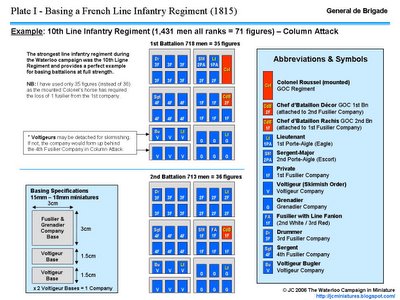
PLATE 2 – Basing French Line Infantry Battalions According to Strength
(Click on plate then maximise screen to view large image)
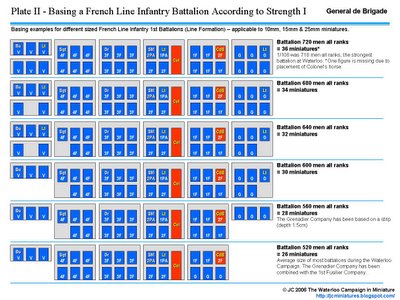
PLATE 3 – Basing French Line Infantry Battalions According to Strength cont...
(Click on plate then maximise screen to view large image)
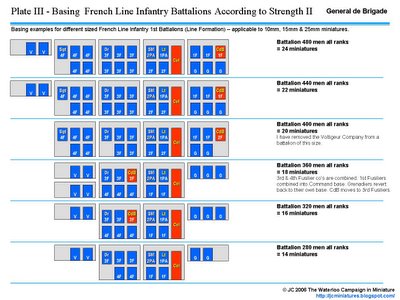
PLATE 4 –French Line Infantry Formations
(Click on plate then maximise screen to view large image)
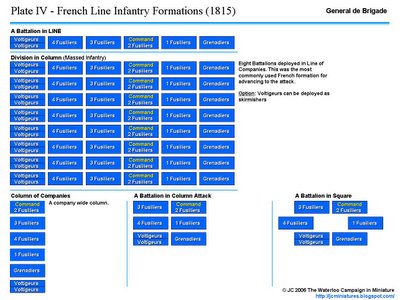
JC
5 February 2006
Posted by
JC - Painter of Miniatures
0
comments
![]()
3 February 2006
Organisation: French Line Infantry Regiments 1815

French Line Infantry Battalion in Column Attack (Eureka Miniatures)
In line my endeavour to replicate my miniature battalions as accurately as possible, this article discusses discuss the organisation of French line infantry and my basing methodology for wargaming infantry regiments during the 1815 campaign.
Overview:
French infantry of the Armée du Nord in 1815 were very poorly equipped. Many historians point out that in line with the speed with which Napoleon re-assembled his army since his escape from Elba, many conscripts were issued with only a shako, greatcoat, belt and musket, wearing civilian clothes underneath.
In 1815, the theoretical strength of an infantry battalion was 900 men though at Waterloo few had half that number. Excluding the Imperial Guard, French infantry were divided into regiments d’infanterie de ligne (line infantry) and d’infanterie légère (light infantry).
At the restoration of Louis XVI in 1814, the size of the regular army was radically cut with the loss of 66 line infantry regiments and then renumbered from 1 to 90. Furthermore, each regiment was reduced from up to 5 battalions to only 2. On Napoleon’s return from Elba, he only had time to partially revise the system allowing regiments to assume their old numbers whilst regiments were raised from 2 to five battalions (in theory rather than practice). On 1 July 1815, new Eagles & flags were presented to each regiment, to be carried by the Porte-Aigle of the 1e battalion on behalf of the entire regiment. These flags were again of tricolour design but lacked the fine embroidery of the 1812 pattern due to their speed of manufacture but carried the battle honours with the addition of those gained in the campaigns of 1812-14.
French Imperial Rank Structure 1815
In order to portray command bases accurately, it’s important to understand the system of rank used in 1815. Many historians inaccurately cite Royalist rank titles in their OOB’s. The Royalist ranks of Louis XVI were dropped on Napoleon’s return to power and superseded with the Imperial rank structure below (NB. I have used the French spelling):
Maréchal (Ney & Soult were the only Marshals on campaign)
Général de Division – GOC Division (2 Infantry Brigades)
Général de Brigade – GOC Brigade (2 Infantry Regiments)
Colonel – GOC Regiment (2-4 Infantry Battalions)
Major – generally staff officers (ADCs)
Chef d’Bataillon – GOC Battalion
Capitaine – Company commanders
Lieutenant – Company officer
Sous-Lieutenant – Company officer
1e Porte-Aigle (Premier) – Eagle bearer (usually a Lieutenant)
2e & 3e Porte-Aigle (Deuxième & Troisème) – Escorts to Eagle bearer (usually a Sergent)
Adjutant-sous-Officier – Senior NCO (RSM)
Sergent-Major
Sergent
Fourrier – supply/admin NCO
Caporal
Homme de Troupe (Private)
Organisation: Battalion
During the Waterloo Campaign Napoleon’s line infantry regiments consisted of 2 to 3 field battalions with an average strength of 520 – far below the proscribed 900. The strongest battalion was the 1/10e Ligne with 718 all ranks and the weakest was the 3/108e Ligne with only 251 men, which I have used as examples for basing. The average height of French line infantry soldier was as follows: Grenadiers - 170cm (5’6”); Fusiliers - 164cm (5’4”)Voltigeurs - 159cm (5’2”).
Each battalion comprised of six companies:
x 4 Fusilier Companies (Centre)
x 1 Grenadier Company (Elite)
x 1 Voltigeur Company (Light – skirmishers)
An average battalion of 520 men all ranks comprised:
x1 Colonel - mounted (1e battalion only)
x1 Adjudant-Chef - in the rank of captain (mounted) (1e battalion only)
x1 Officer-Paymaster - he went with troops overseeing pay and financial records
x1 Chef d'Bataillon - mountedx1 1e Premier Porte-Aigle (1e battalion only)
x1 2e Porte-Aigle – Escort (1e battalion only)
x1 3e Porte-Aigle – Escort (1e battalion only)
x1 Adjudant-Major - in the rank of captainx6 Capitaine (Captain - 1 per company)
x12 Lieutenant (2 per company)
x18 Sous-Lieutenant (3 per company)
x1 Adjudant Sous-Officer – the Senior NCO (1 per battalion)
x1 Drum-Major
x6 Sergent-Major - in the rank of senior NCO (1 per company)
x18 Sergent (3 per company)
x 38 Caporal (6 per company – 2 as escorts to the Eagle)
x12 Drummers (formed behind 4th & 1st Fusilier companies when in column attack)
x 403 Hommes de Troupe (Privates)
NB: Not included in these figures are the non-combatants attached to the regiment including:
x1 Surgeon & his aides;
x1 Shoemaker
x1 Gaitermaker
x1 Gunsmith
x1 Tailor
& musicians.
UNIFORMS 1815
Click on the links below to view Alexis Cabaret’s brilliant uniform plates that feature seven figures on each:
Figure 1 – Officer
Figure 2 – Drummer
Figure 3 – Sergent (Sergeant)
Figures 4-6 – 3 examples of a private
Figure 7 – Caporal (Corporal)
Fusilier Uniforms
Grenadier Uniforms
Voltigeur Uniforms
To see all his uniform plates click on the image below
JC
3 February 2006
Posted by
JC - Painter of Miniatures
0
comments
![]()
1 February 2006
WORKBENCH #3 - 18mm French Line Infantry (Eureka)
More photos at the bottom of this article.
Click on image for unflattering close-up!
I have just finished painting my first French Infantry battalion using the 18mm Post-1812 Napoleonic French Infantry recently released by Eureka (& superbly sculpted by Alan Marsh) - see release. Firstly, may I take my hat off to Eureka in the efforts to produce figures for us 1815 Napoleonic enthusiasts. AB Miniatures excellent range of Napoleonic figures has sadly a gaping hole with regards to the Waterloo campaign, so I am extremely pleased to read that not only are Eureka employing Alan Marsh to fill this gap, but as of 1st March 2006, Eureka will become the sole World-Wide manufacturer of AB figures’ entire Napoleonic range and they mention in their press release, "AB Figures march to Eureka" that they have some surprises up their sleeve!
Having bought a French battalion from Fighting 15s – the site of legendry painter Ian Marsh (not to be confused with David) as a Christmas present to myself, I was instantly impressed with the detail and quality of each figure as well as the distinct lack of excess metal or “flash”. As a devotee of detail, I found I could paint the same amount as I’d apply to a 28mm figure. The only downside of miniatures of this size is the delicacy of the bayonet, which can easily snap off – c’est la vie!
Anyway, here’s a collection of photos of my first completed battalion ~ 1e 72e Regiment d’Infanterie de Ligne ~ or in English, 1st Batallion 72nd Line Infantry Regiment based according to General de Brigade rules (1 figure = 20 men).
1e Batallion 72e Regiment d’Infanterie de Ligne (1815)
Acting GOC Chef d’Bataillon Thibault
Attached to: 5e French Infantry Division – 2e Brigade under Général de Brigade Campi
Basing:
A full-strength French line infantry battalion of 720 men would consist of 6 bases:
Base 1: Command (x1 GOC Regt. x1 Eagle x1 Escort) + 1st Company of Fusiliers (x3 figures)
Base 2: 2nd Company of Fusiliers (x6 figures)
Base 3: 3rd Company of Fusiliers (x6 figures)
Base 4: 4th Company of Fusiliers (x6 figures)
Base 5: Company of Grenadiers (x6 figures)
Base 6 & Base 7: Company of Voltigeurs (x3 figures per base for skirmishing)
Like most French line infantry battalions in the Waterloo Campaign, the 1e 72e was under strength numbering 483 men all ranks. This equates to a 24 figure battalion and, as you can see in the photos, I have adapted the above formula to accommodate the battalion being under strength, i.e.
Base 1: Command (x1 GOC Regt. x1 Eagle x1 Escort) + less than half a Company of Grenadiers (x2 figures)
Base 2: 2nd Company of Fusiliers (x6 figures)
Base 3: 3rd Company of Fusiliers (x6 figures)
Base 4: 4th Company of Fusiliers (x5 figures)
Base 5: Not applicable (Grenadiers accommodated within Command base)
Base 6: less than half a Company of Voltigeurs (x2 figures per base for skirmishing)
= 24 figures i.e. 480 men.
Each Company base is 3cm x 3cm and easily accommodates a max. of x6 18mm figures. The anomalies in the 1e 72e are:
Anomolies:
- Normally the GOC (General Officer Commanding) an infantry regiment was a Colonel but in the case of 1e 72e there was an acting GOC who was a rank below, i.e. Chef d’Bataillon Thibault. Therefore, for the purists, you will note I have painted his plume all white with one gold band around his shako signifying the rank of CdB and not a red plume with two gold bands for a Colonel – call me fussy if you want.
- I have incorporated the Grenadiers into the Command base.
- I only have one base of Voltigeurs and if you look closely you’ll see a furrow made by a cannon ball where the third Voltigeur should be! TIP: Use any space where a figure would normally be creatively!
- The 4th Company of Fusiliers has a figure missing and again, if you look at the relevant photo, you’ll notice a small crater with canon ball imbedded in it!
Finally, to add a bit of realism, I’ve placed a couple of loafs of bread and two slabs of pork on the bayonets of 4 figures. Again, for purists comme moi, infantryman often carried food skewered on their bayonets due to lack of room in their haversack – if they were fortunate to have one. - French infantry in 1815 were very poorly equipped with many conscripts issued only with a shako, greatcoat, belts and musket, wearing civilian clothes underneath! To depict this dire state of affairs, I have painted the trousers a variety of colours other than the regulation campaign blue or white.
- Finally, despite the 16th June being a fine hot summers day, the 17th was one of the wettest and when units met on 18 June at Waterloo, their uniforms would have been extremely muddy. Therefore, I have painted mud on the trousers and the bases show churned up grass.
Well, 24 figures down and 2, 476 to go! Merde!
JC
1 February 2006
---------------------------------------------
NOTE: When viewing my figures close-up please remember that they were NOT painted for such close inspection and are best viewed atop a wargaming table. Let's just say that I'm allowing you to see how my paint is applied. And for the purists who lean toward more realistic blending, I promise to have a go at this style when I begin painting the 2e battalion.
Command Base
2e Fusilier Company / 3rd Fusilier Company
4th Fusilier Company
Voltigeurs
Column Attack!
Painted ~ Unpainted!
Posted by
JC - Painter of Miniatures
4
comments
![]()
